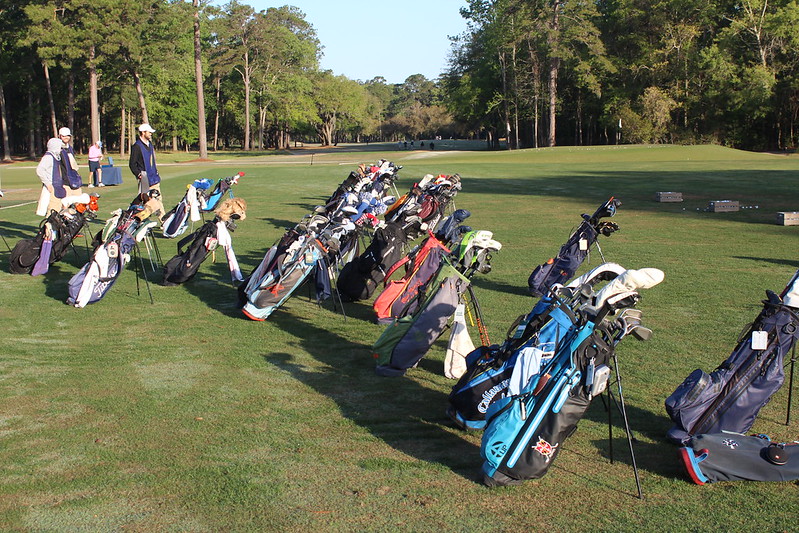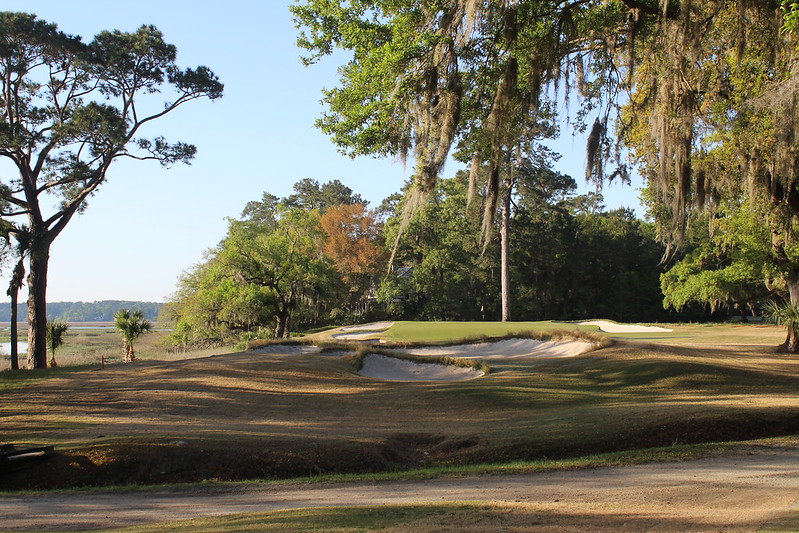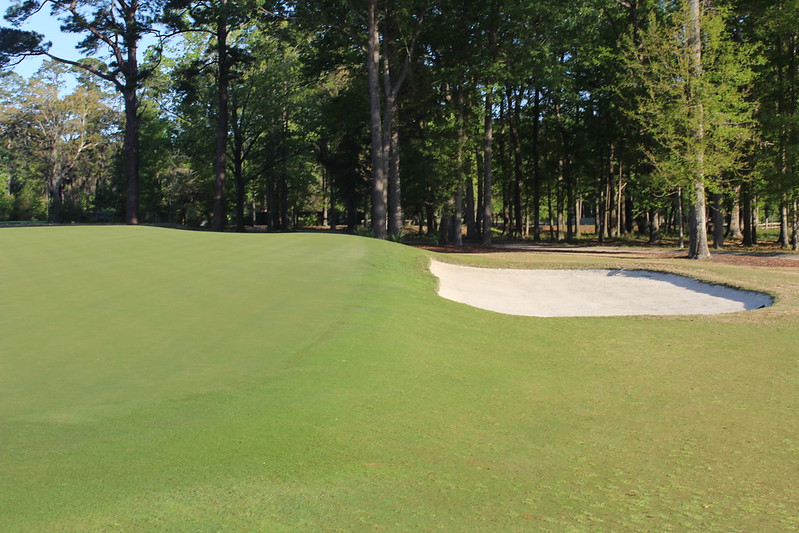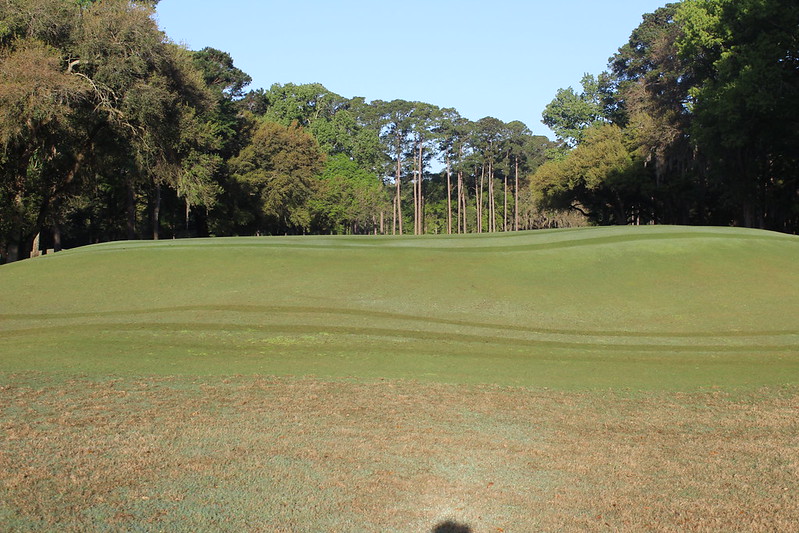The Chechessee Creek Club logo features a feather with a golf pin and flag inset
It has been a long time since I posted anything and it is nice to be back. The pandemic years have been trying for all of us and especially for me. With a very bad immune system I have to be overly cautious. She who must be obeyed (my doctor) gave me a very simple instruction, and I have followed it to the letter: don't get Covid. Hopefully this pandemic era is over and we can return to normal life. On the health front, I am doing well and am in remission, the ultimate blessing. The bargain you make when you have a bone marrow transplant following leukemia is to trade death for a series of chronic illnesses, something I have gladly done. My day is always focused around treating my afflictions and managing the pain. Gabapentin, a non addictive medicine to manage nerve pain for my feet and eyes, is a godsend. I have to do four inhaled medicines via a nebulizer daily for my lungs, and I take about twenty pills a day for various things. My biggest problem remains severe acute dry eye, which means I have to put in eye drops at least every hour, wear sunglasses at all times, and avoid high winds. Not ideal for a golfer, but damn the torpedoes and full speed ahead.
Despite all my ailments I have been playing golf at least twice a week and am excited this year to start traveling again. On the agenda are Friars Head, Maidstone and Westhampton, as well as (god willing) a trip to Scotland in September, finally, after postponing it three times.
Today's post is about Chechessee Creek, located in the South Carolina Lowcountry, in the town of Okatie, which is roughly thirty minutes north of Savannah and thirty minutes west of Hilton Head. I am worn down living in New Jersey during the winter so we are building a house less than ten minutes from Chechessee, which I have joined. It is a dream come true. The Lowcountry is a geographic area along coastal North Carolina, South Carolina, and Georgia characterized by flat lands, often below sea level, filled with salt water tidal marshes thick with cord grass, and loads of coastal waterways. The Lowcountry has a unique culture with distinct architecture, traditions, and food. This area of South Carolina historically had an economy that relied on agriculture for hundreds of years. The main crops grown on antebellum plantations were rice, cotton, and indigo. 81% of the population in the county Chechessee Creek is located in were slaves in the 1860s, among the highest in the South. The articles of secession in the Civil War were drafted 15 miles away in Beaufort. This is the Deep South.
The clubhouse at Chechessee exudes Lowcountry charm
Chechessee Creek was built in 2000 and the club has a distinctive feel to it. The club occupies a sprawling 300 acres among tall pine trees and centuries old live oaks dripping with Spanish moss. The secluded and semi-remote location gives the course a great understated vibe, with a nostalgic feel.
The designers of the course, Ben Crenshaw and Bill Coore, said the following about the club, and they achieved their stated goal, "Our goal at Chechessee Creek Club was to create a golf course of traditional character that would reward thoughtful, imaginative and precise play; while utilizing and showcasing the magnificent oaks and pines of the Carolina Lowcountry." Chechessee was the brainchild of two Jims: Jim Chaffin and Jim Light, who were involved in the development of the original Sea Pines resort on Hilton Head Island.
Chaffin, who played collegiate golf at the University of Virginia, also achieved the goal he set out for the club, "We built Chechessee to remind us of golf’s Golden Era. We wanted it to be about the contextual relationship with nature, about being in the elements. The love of the game was the overriding principle in every decision we made. It was always about the golf.” As he and his partner were designing the course, Ben Crenshaw visited other great South Carolina courses (Yeamans Hall in Charleston and Palmetto Golf Club in Aiken, specifically) for inspiration in his Chechessee design.
The course is beautifully routed through the tall pines, specimen oaks, and Palmetto palms, and over marshland. The first half dozen holes play inland and the seventh and eighth holes play along Chechessee Creek. The course then goes back through the trees to the clubhouse and then emerges again along the Creek at the thirteenth and fourteenth holes before routing back again through the trees. You can debate who the best modern architects are among Tom Doak, Gil Hanse, and Coore/Crenshaw, but I think that Coore/Crenshaw for sure win the prize for best routings.
As they typically do, the architects give you a gentle opener (tee to green at least), a par four of 372 yards. The first hole might have the the smallest green on the course, raised off the ground a good distance for a course built on flat ground. To top off the challenging green, it also has a false front. It sets the tone for the day: wide fairways and elevated, pushed up greens with severe slopes left, right, and back. Coore and Crenshaw's courses always give generous landing areas off the tee. Driving the ball usually doesn't create too many problems, even if you are off line a little. The key is playing well around the greens to a much larger degree than courses designed by other architects. The number one rule when playing Chechessee is that if you are going to miss, miss short of the greens. They are all narrow and slope from back to front.
Bags and caddies on the range, awaiting a full day of golf. As a course with a large national membership, the caddies line up the bags in the morning for golfers eager to soak up the Lowcountry vibe
Although the fairways are generous at Chechessee, that doesn't mean that simply hitting them will position you to hit the green. Case in point is the fourth hole, a 408 yard par-4 that plays as the #1 handicap hole. Being on the left side of the fairway positions your shot to the green more favorably. The same is true of the ninth hole. The finishing hole requires the opposite, a drive to the right side avoids the overhanging trees that come into play on the left. Such is the chess match that you will have all day trying to work your way around the course.
I don't really like the term signature hole because it slights other very good holes, but if there were a signature hole at Chechessee it would be the par three seventh, playing 178 from the tips. The three jagged bunkers in front of the green create an optical illusion and doubt, although unless you top your tee shot they don't come into play.
The 7th green from the tee with a panoramic view of Chechessee Creek along the left
Darius Oliver, author of the Planet Golf series of golf books is a big fan of the par threes at Chechessee, "As strong as the longer holes are, it’s the par threes at Chechessee that elevate the golf to a higher level. As a set there are few better anywhere on flat land. The 7th is a glamorous hole played from beside the marsh and across a bunkered mound that partly obscures a clever false front green."
As seen below, the seventh is a typical green at Chechessee with its back to front slope, and as Darius notes, a false front. As I said, short is always the best option for a miss.
7th green bunker on the right
A closeup view of the 7th green showing the slant of the green and a jagged bunker you don't want to mess with.
7th green bunker, left side
The left side of the green is no easier, with two bunkers.
Jim Chaffin's mandate to Coore and Crenshaw was to build a course that, "Felt like Raynor, Ross, Tillinghast, and McDonald might have come back in a time warp and have collaborated on." That's quite a mandate. While the course doesn't have any of the prototype holes that MacDonald/Raynor are famous for, nor none of the sparkling bunkers Tillinghast is known for, it somehow does have a throwback feel to it. This is probably due to the success of the routing, the ease which which you go about your round, the visual appeal of the course, and, most importantly, that intangible quality that is tough to put your finger on that makes Coore/Crenshaw courses so magical.
Of all the designers mentioned in the brief the owners gave the designers, in my view the architect the course most closely resembles is Donald Ross because of the closely mown areas and fall offs on almost all of the greens, although the bunker styling is distinctively Coore/Crenshaw.
8th green, left side
The eighth hole is a par four of 440 yards and plays in the opposite direction of the seventh. It is a stern test of a golfer's ability to accurately hit a long iron shot to a demanding green. The picture above shows the penalty for missing left. The tricky part of getting up and down is that the green is narrow and designed to be approached from the front and not the side, thus, an accurate high sand shot that lands softly is required. Anything coming out of the sand that runs will likely leave you . . .
8th green, right side
. . . either in the bunker seen above, or in the shaved area seen in front of the bunker. Whenever I play at Chechessee I always spend some time on the practice area hitting long lag putts from off the green because undoubtedly I have several during your round.
The course plays 6,641 from the tips to a par of 70. Since the course is on flat ground and the next tee is always near the prior green, the course is a nice walk, even when it is hot and humid. You should always hope for a little breeze as protection against the bugs coming out of the marsh. The course, and especially the greens, are always in top notch condition. As an isolated course away from any hustle and bustle, playing is always a serene affair (unless there are morons playing music from their bag or cart, which I will never understand). When I go out first thing in the morning with a caddie, we are comfortably finished in 2 1/2 hours, the ultimate way to experience this great game.
Par 3 11th green, left side
The par three 11th (212 yards from the tips) is a challenging hole, once again, because landing on either side of the green leaves you a testing shot to a sloping green. The 11th is the start of the best four hole stretch on the course with two demanding yet varied par threes interspersed with two very different par fours, each presenting their own challenges. None of the holes are remotely similar and all four play to different points on the compass.
Par 4 12th hole from the tee. One of the few forced carries on the course
The 336-yard 12th requires the golfer to traverse the marsh between tee and fairway. Darius Oliver describes it better than I can, "It may be short, but the hole demands a nervy drive—a 165-yard carry over an inlet from all but the forward tees."
Chechessee was blessed to have former Pine Valley president Ernie Ransome as the chairman of the club's advisory board in the early days. Jim Chaffin says that Ransome gets credit for the diabolical little bunker that pinches into the front of the 12th green, which slopes off steeply around it, “I’ve seen people putt into it from above the hole.”
After the fun and challenging 12th, the course routes seamlessly back into the heavy forest. The flow is just so natural. Be on the lookout for fox squirrels, with their distinctive large ears; they are throughout the course, as are eagles soaring above.
The 13th green at dawn
The view above is from the 13th tee, a 164 yard shot. Long is again the worst option; best to always play a little short if you have any doubt. This image also shows to good effect the push-up style greens Coore/Crenshaw designed on the flat property. Darius Oliver on the hole, "As with so many of the greens at Chechessee, the 13th seems simple from the tee and it’s only after walking off with yet another soft bogey that you appreciate just how well you have to hit the ball here in order to score well."
14th green, right side
The 14th hole, a 404 yard par four, has the most severe green on the property, and is another with a false front. There are no greenside bunkers, which is always a red flag that the green is going to be difficult because the architects are going to compensate for the lack of a sand penalty with a tough green. Once again, going long on the green leaves you a very difficult shot to get up and down, particular if the pin is in the back because the green slopes from back to front.
14th green, left side
The shot above shows the left side of the green and the slope of the putting surface. It is no easier than being right or long. A precise flop shot with soft hands is required if you miss the green left, particularly with the pin location seen here.
The 17th hole is short, but demanding. It is only 334 yards but is a classic risk-reward hole. Playing left is a safer bet since there is a sliver of fairway in the landing area. The right side of the hole has a marshy area jutting out into it that seems to attract tee shots. Big hitters can try to drive the marsh completely by playing down the right side, and if they make a good shot they will be rewarded by being near the green.
Bunker, right side of 18th green
The finishing hole is a 442 yard par four and the golfer should once again follow the cardinal rule at Chechessee and not be long into the green. Even a scratch golf would have to use all their skill to get the ball close to the hole from over the green. Each side of the green has a jagged bunker like the one pictured above. The green is one of the longest and skinniest on the course, so good luck keeping the ball on the green when you splash out of the sand from either side.
If you have hit over the 18th green, you have made a big mistake and requires a Mickelsoneqsue short game to get up and down. Oops!
As a club with a large national membership, Chechessee caters to golfers who bring a group to play a few rounds. The lodge and cottages and comfortable, with classic Lowcountry features: screened in porches that are cigar friendly. a front porch to soak up the environment, and outside fire pits.
The test of any Lowcountry club is their shrimp and grits, and the version here is excellent, as is the chowder. They also serve a proper Southern breakfast which includes biscuits and gravy. If you are on a guy trip, a great option for lunch or dinner if you want to be loud or watch golf while you eat is the men's locker room which is outfitted with nice tables, leather chairs, and flat screen TVs.The club also has a large and excellent caddie program, which in my opinion, always enhances the round of golf.
In Tom Doak's Confidential Guide to Golf he ranks Chechessee Creek among the "Most Understated," along with Cypress Point and Yeamans Hall. Again, Darius Oliver hits the nail on the head describing the course, "Although holes like the 7th, 9th, 11th, 12th and 13th are undoubtedly first-class, Chechessee Creek is greater than the sum of its parts thanks to its lay-of-the-land design, stunning cottage-style clubhouse and pure golf-only focus."
The last word goes to the two time Masters winner Ben Crenshaw: “It’s Lowcountry, but it’s low key. It’s a very quiet place to play golf. It’s really that simple."


















